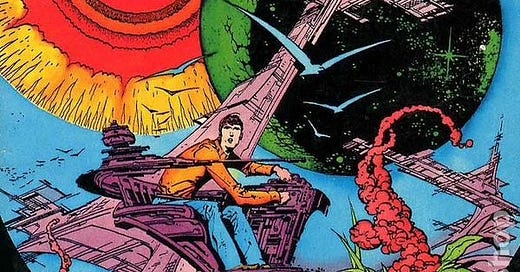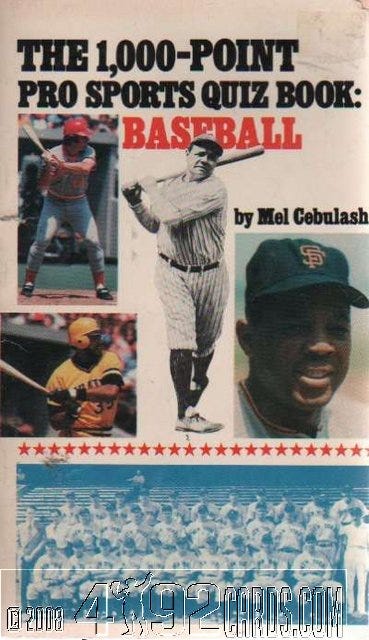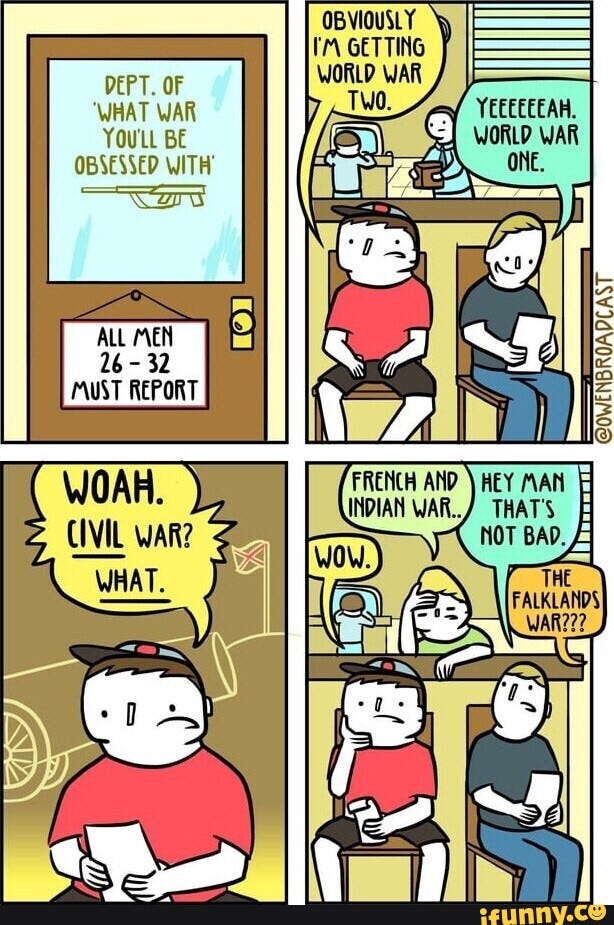Part Two
It looks like Part One garnered a good reception, now for the important question: So what?
I saved this part for its own post because the first one ran longer than expected, and readers needed an opportunity to chew on it for a while. Also, we’re going to get a little esoteric in this one, so bear with me again.
I’ll make some disclaimers:
First, these are my own thoughts and opinions (Intern Steve / Editor Chris).
I do not speak for any other member of Raconteur Press, or the press itself. As I’m officially retired from the Air Force effective 1 February 2025, you can also surmise that my opinions do not represent the opinions of the US Air Force, the Department of Defense, or the United States government.
Second, there is no one single specific theory or school of thought I’ve brought into play here; this is a composite view gleaned from a lifetime of learning and experience thus far.1
Third, I do not have a degree or any credentialled expertise in English, literature, creative writing, theology, mythology, anthropology, or psychology.2 If you’re really hung up on CV, I’m happy to compare notes, but I doubt I’ll impress you or anyone else.3
Now, let’s talk about the threads of commonality that one tends to find in boy’s adventure stories. Notice I didn’t say “tropes,” and that’s on purpose.
Thread 1: Potential Worth versus Inherent Worth; Boys are all about Potential.
Let’s face it, boys, and men both are rarely, I would argue almost never appreciated simply for existing in everyday life and culture throughout human experience and history.4 Everything about our lives in the human world revolves around our potential, and how closely we attain, surpass, or fall short of that potential.5 I argue that aside from certain religious and philosophical points of view, boys and men are treated as having very little inherent worth apart from their potential worth, in the eyes of the world.6
We usually are loved much more for what we do than for who we are.
Built into this are a host of assumptions of the inherent characteristics one possesses by being male; biologically, mentally, morally, and functionally. From my perch, many if not most of those assumptions are well-backed by reality, like it or not.7
This also creates assumptions as to what must be added through expended effort, or given externally, and thus gained and obtained. Those are much more flexible, and culture, patterns of family formation, experiences, play a tremendous role in setting those assumptions and expectations.
This is built into our biology, our brains, our minds, hearts, and souls. It plays out repeatedly in our myths and ancient stories. It’s in our religion. It plays out in the organization of our societies and politics. I’m not going to delve into the pros and cons, better or best, I’m just arguing for its existence.
Thread 2: Archetypes
In this you see enormously powerful archetypes emerge such as triumphant hero, everyman or “pilgrim,” and tragic hero. There are models of the types of male archetypes, such as the famous Warrior, King, Magician, Lover.8 There’s the model of “priest, prophet, and king” from Jewish and Christian theology.9
I’ll discuss archetypes more below, where they most appropriately fit.
Thread 3: Claim - There’re only three types of boy’s stories.10
Disclaimer - you’ll see some of the same characters and stories pop up in more than one of the three outlines I describe below. That’s because the larger narrative of those characters, those stories can contain two or even all three of the types, transform from one into the other, or serve as preludes, sequels, and spin-off stories. See if you can spot how and when that happens.
First, the most dominant, which often becomes tragic, such that I call it the “noble pagan model of doom,” is the “Performance Based Mindset,” as one of my teachers of psychology and faith formation puts it. “I DO, in order to HAVE, to BECOME who I was created to be.”
This is the activation of and exceeding potential or forcing oneself beyond inherent limitations. Stealing or inventing fire, for good or ill.
This is a powerful model. It’s related to the Hero’s Journey, but it doesn’t exactly map onto it, and that’s because the Monomyth isn’t the sole story told in the world, or at least, it’s an incomplete model of all the world’s stories.
The power of this performance model of story is that it can track towards good or evil, switch between both, and it supports stories of conquest, revenge, achievement, survival, and growth, and even the story of a tremendous fall.11 It describes a hero who lives up to expectations, or the conquering barbarian who overthrows a decadent old order.
On its positive side, you achieve and become “somebody” greater than who you were; the boy becomes a man, the man becomes a hero, the hero becomes a king and now shares his rewards to establish justice, reward virtue, marries the princess, lives in wealth and happiness forever, at least until the next call to adventure, and quests to become someone even greater.
That second call and beyond could be to achieve spiritual greatness. This is Batman when he’s well-written, or Spider-Man. Or Tony Stark. Or Taran the Assistant Pig-Keeper. Or this could be Conan and Beowulf, when they are finally and heroically struck down in their old age by foes beyond their abilities but still fighting to the very end.
Good videogames embody this, sometimes embracing the after-story, of decline, fall, passing to the next generation, or regeneration, sometimes eschewing it.
It can also describe loss, decline, raging against an unfair world, fighting against the odds, fighting against society and oppression.
The dark side of this includes “success at any price.” Let your imagination run wild. It can also mean tearing things down just to watch it burn. Even in the modern workplace, you have Fight Club, and you have American Psycho as the darkest expressions of this. This is Doctor Doom.12
The second story is like the first but ordered differently and thus intended differently.
Again, drawing from my instructor Dr. Nick, I AM somebody, I HAVE something because of who I AM, therefore I GO DO, because it is the right and just thing. In this respect, think of the tales of Arthur and his Knights in the quests they undertake every Feast of Pentecost, or Charlemagne’s paladins. Or Zorro. Or Aragorn. They set out to put the world right because they are duty bound by higher authority.
They are made to do it, in multiple senses of the word “made.”
This is a very medieval and ancient outlook that parallels, but in many ways inverts the other.
If the first story is Prometheus, this one is that of the heroic Saint and if tragic, the Martyr. Dare I say it, this is the Gospel story. The greater achievement or victory comes after the GO DO, but the entire will to GO DO is driven by who the protagonist is and what he embodies.
I accept the gifts given to me and I give them to the world, I don’t take from it.
It’s fulfillment of potential. It’s not just achievement or attainment, it’s fulfillment. That’s a very different sense and goes to show you why words do matter. They matter very much, and one isn’t as good as another all time.
The second story can contain one or more iterations of the first one along the way. It often transforms it.
If done right, this is Superman as he should be written.
Sometimes they show a parallel Type 2 to contrast what the protagonist can and should be, or more often these days, to nihilistically mock Type 2.
Type 3 is “the adventures of the force of nature.” What I mean by this, is those stories where there’s no arc. The hero simply “is” potential energy converted into kinetic. A lot of pulp heroes follow this thread, and there’s nothing wrong with this.
So do many Westerns and Samurai heroes and traveling martial artists. Men with no name. Doc Savage. Solomon Kane. There was a Type 1 or Type 2 story that made him this way, but we don’t care because it’s in the past, he now is who he is, and he does what he does, and lots of bad guys pay for that.
I’ll stop there. That’s enough to chew on.
Addendum 1:
Let’s move on from the seriousness of the above to something sweet and to the point. This also probably deserves its own post, but we’ll see how it goes.
Many boys also like sports, and like sports stories. They don’t have to love them or be fanatical about them to the exclusion of everything else, but chances are they like them. Everything we discussed in the sections above applies here too.
If you have a tough time imagining what I’m talking about, then you really need to go watch The Sandlot. Stop reading right now and go watch it because the rest of this point won’t be useful to you. If you cannot understand the appeal of that movie, then you shouldn’t be writing children’s literature. You don’t have it in you.
If you’re one of those “durrr sportsball” types, keep it to yourself.
Addendum 2:
Men and boys also like war stories. Like sports stories, they contain multitudes of examples of Types 1, 2, and 3 stories, hybrids, edge cases and variants.
While every man will eventually be issued his own particular war to obsess over, a great place to start your boys is here.
I will do my absolute best to source and properly cite all outside sources for the ideas expressed in this post, where possible. If I inadvertently leave something out, and you catch it, post it in the comments and I will amend this article as needed to give credit where credit is due.
As for psychology, that’s more “not yet.”
Please note also that I do not give two flying f’s.
Our reproductive biology lends itself to this, if you take it from the cold standpoint of genetics and biology.
I want to specify that idea is not original to me, however I’ve struggled to find any one source that I can point to and say, “this is the one, this is definitively where I first saw this.” Per Note 1, if you have it, please repost it.
We could spend an entire year just discussing how this plays out in the works of Charles Dickens, especially David Copperfield, Great Expectations (it’s in the flippin’ title for Pete’s sake), and even A Tale of Two Cities, just to get started.
I’m not going to delve into edge cases or exceptions in this post. Yes, they exist. There, feel better now? Variations and outliers from the norm are real. So’s the norm. Normal is not a slur, it’s a simple statement of fact.
For purposes of this article, I am not delving into personality types (Myers-Briggs), or specific Jungian theories, or the popular sexual-social hierarchy concept, i.e., “Alpha-Beta…etc.” It’s beyond the scope of this article and tends to kick over more cans of worms about the reliability of sources and its proponents than useful conversation.
See this column by Catholic Bishop Robert Barron - https://www.catholicnewsagency.com/column/52817/priest-prophet-and-king. I am unapologetically Catholic, so if there’s a version of this concept you prefer from Jewish (especially regarding the concept of Davidic kingship) or Orthodox Christian or Protestant theologians, be my guest.
Yes, variants exist, but a variation on a theme does not always warrant its own separate category.
Or, in a more Christianized version such as Tolkien’s “Long Defeat” concept, which still has roots in the pagan sagas, and is heavily expressed for him in the stories of the House of Feanor, the saga of the Silmaril jewels. As Tolkien framed his work as a pre-historical mythology of Europe (and the world), it drives toward a Catholic Christian eucatastrophe, as described in his Letters, 144 especially.
You’ll have to finish this on your own, too much to delve into here.







Doctor Who used to be a great "Man With No Name" character - the OG, anyway. Shame he was regenerated into a CW trope.
"I’m not going to delve into edge cases or exceptions in this post. Yes, they exist. There, feel better now? Variations and outliers from the norm are real. So’s the norm. Normal is not a slur, it’s a simple statement of fact."
I think it was Chesterton who said, paraphrasically (and perhaps allegedly), it is the exception that proves the norm.
Great post.